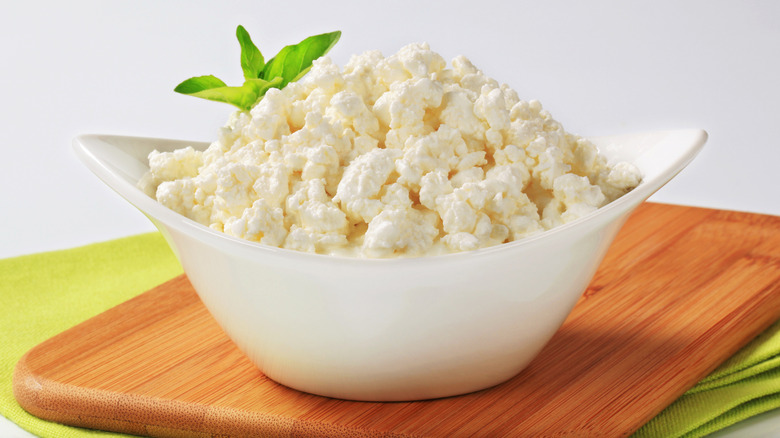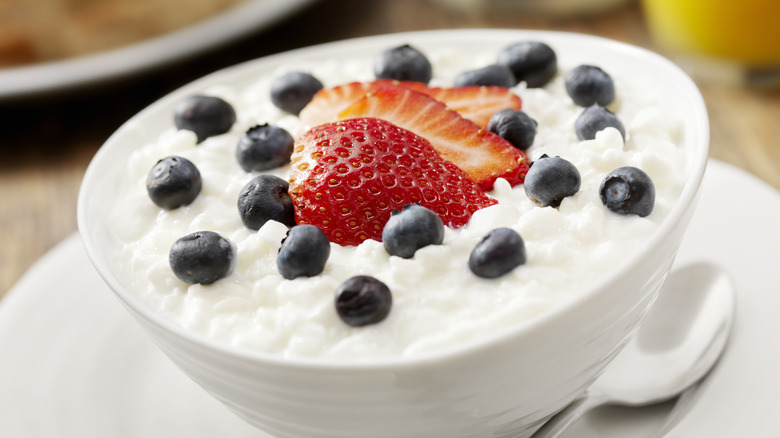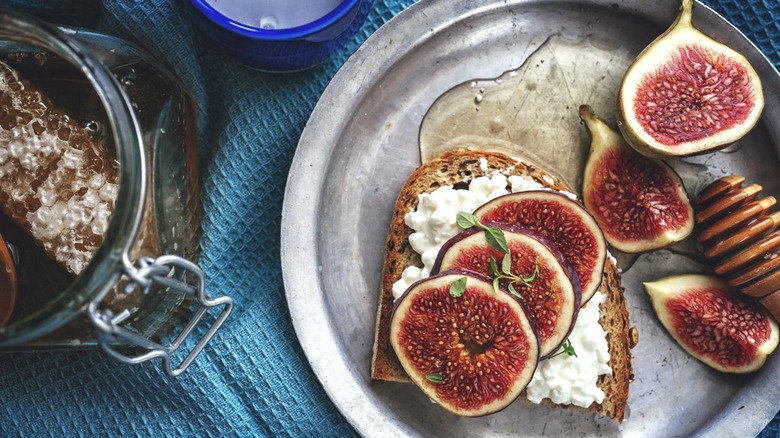Why Cottage Cheese Has That Chunky Texture
Whether smeared on toast or blended into pancake batter, cottage cheese is an old-fashioned favorite that has found new attention on social media. You might see influencers rave about the taste and health benefits of this product, but to those who haven't tried it (and plenty who have), the chunky texture of the cheese can be hard to get behind.
Understanding how cottage cheese gets its signature texture can erase trepidation about trying it. The "lumps" in the cheese are merely cheese curds, the foundation of all dairy cheeses. When certain enzymes, active cultures, or acids are added to dairy milk, it separates into liquid whey and solid curds. To make a firm or hard cheese, the curds are processed into a solid block, but there are also "fresh" cheeses that are treated differently to create unique flavors and textures. These include feta, ricotta, and of course, cottage cheese.
To make cottage cheese, cheese curds are cooked to extract moisture, then washed, creating a crumbly block that is then cut into smaller pieces. You can buy cottage cheese labeled as small, medium, or large curd, depending on the size of the pieces. The curds are then mixed with a dressing made of ingredients like cream, milk, salt, and citric acid. The final product features firm yet creamy chunks of cheese in a rich liquid.
Cottage cheese can also be made smooth
Cottage cheese is similar to other products made from strained cheese curds, such as farmer's cheese and pot cheese. However, cottage cheese is unique due to the inclusion of a dressing. Because the curds in cottage cheese are cooked and pressed, they have a pleasant, "squeaky" texture, somewhat similar to fresh cheddar cheese curds. Rinsing the curds also removes some of their sharp tang, creating a mild flavor that lets the luscious and creamy texture shine. There's a slightly tangy flavor in the background, with a milky, subtly salty taste at the forefront.
Cottage cheese's taste is mild enough to support both sweet and savory additions. You can scatter berries and granola or sea salt and olive oil on top and go to town. If you can't get behind the chunkiness, though, there are plenty of unorthodox ways to use cottage cheese that mask its chunky texture. Blend the cheese until smooth to make a creamy dip or sauce, or whirl it into smoothies. You can also find smooth, whipped cottage cheese at grocery stores.
Fans of cottage cheese know that it packs a nutritional punch. A ½ cup serving of low-fat cottage cheese has about 14 grams of protein. It also contains necessary vitamins and nutrients, and there are no-salt-added versions available for folks on a low-sodium diet. Additionally, it just so happens that cottage cheese can be an effective hydration booster.
More ways to enjoy cottage cheese
If you don't mind the chunks in cottage cheese, but wish it were just a little smoother, try giving it a few quick pulses in the blender, instead of blending thoroughly. The consistency will be easier to scoop with chips or fresh veggies, while retaining a bit of a toothsome bite. Mix in your favorite seasonings to make a quick dip that could also suit crispy potatoes or chicken tenders. Try mixing in a ranch seasoning packet, an everything bagel spice blend, or some Old Bay.
You can also get a bit more involved by blitzing the cheese with fresh garlic, tender herbs, or even nutritional yeast. This makes for a great sandwich or toast spread. Cottage cheese can also add creaminess to a lasagna in place of ricotta, or mix it into a frittata or egg bake. You can even spread it out on a plate and top with a fresh tomato and peach salad, finished with a balsamic dressing and fresh basil.
Cottage cheese also makes a good replacement for other dairy products. You can use the cheese in place of yogurt when you feel like enjoying some extra textural intrigue and a less acidic taste. It can also stand in for cream cheese when you want a little less richness. There are so many ways to use this cheese that anyone should be able to enjoy it, whether chunky or smooth.



